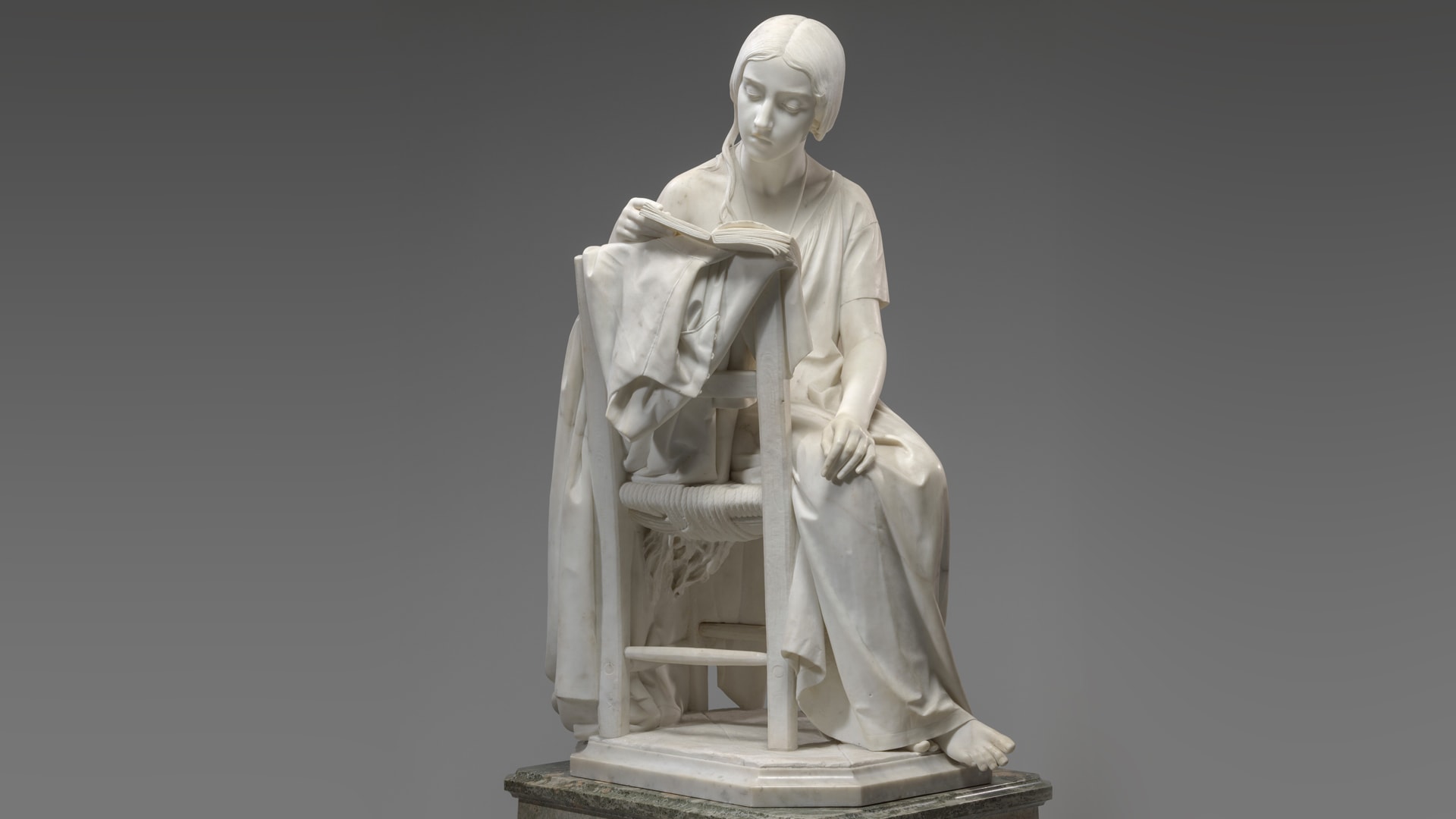
In 1979, having had some supernatural experiences that—according to the atheism I had been soaked in from the amniotic fluid on out—I could not have had, I was primed for what soon, and expectedly, followed.
Rushing to catch a flight from Schiphol, Amsterdam, I clutched two Granny Smith apples in my hands when, suddenly, I was stopped, cold—my eyes bugging out my head (surely). With a clarity so focused that faith seemed redundant, I could see the love that God had poured into those apples. It were if heart emojis were floating out of them, and I could feel God’s smiling down on me. For the first time in my life (I was 23), I knowingly, and unmistakably, saw the reality of God’s love as revealed in nature.
And now, 44 years later, I can’t unsee it. That is, most everywhere I look, I see not only God’s creative power but the love that suffuses it.
Flesh to Marble
Recently, at the Smithsonian, I encountered a white marble statue, The Reading Girl (La Leggitrice), sculpted in 1861 by Pietro Magni. You have to experience it yourself, flesh to marble, to grasp it, even though I couldn’t grasp it in that I couldn’t grasp how some fallen mortal could have etched and hewed her out of the stone. The details, the texture, the design, and the emotions they evoked stunned me into an astonished numbness.
Yet it was a stinkin’ rock. A single skin cell of Magni’s model was qualitatively so much more complex and crafted (it was, after all, alive!) than the whole statue itself that it would be futilely unfair to compare them, even more so than comparing “e=mc2” penciled on paper to the forces that make stars burn and shine.
If the universe existed 10 times longer than now theorized, La Leggitrice could not have arisen by chance. Which is why, thousands of scientists declaring that “overwhelming scientific evidence” shows humanity arose by chance—means nothing to me. They might as well declare “overwhelming scientific evidence” for the stork delivering babies; that’s how far beyond evolution I’ve become because of things like La Leggitrice, which I can’t unsee.
I have on my desk a green Wedgewood ash tray inherited from my grandmother (I came from a family of heavy smokers). It’s ceramic, a piece of clay, and yet the design, the purpose, the function is all so obvious that it could have no more arisen by chance than did La Leggitrice, a rock. And yet we’re assured, based on things like genetic mutations supposedly millions of years of years ago, that the human brain, a bit more intricate than Grandma’s ash tray, arose that way. Please, I could believe in the birth of Minerva out of Jupiter’s head before believing the party line on origins.
I’ve harped on this before, and my poor wife tires of my morning rhapsodies over fruit, but I can’t unsee it. Whatever the fruit, hybrid or no, it’s about as certain “proof” as I’ll ever need that the whole “unsubstantiated just-so stories” (to quote pioneering evolutionary biologist Richard Lewontin) of evolution compose another scientific dead end, like phrenology, or the geo-centric view of the cosmos (Which lasted, what? About 1800 years?).
A Guiding Force
Evolutionary biology tells us that natural selection (which must itself have arisen by chance) is the guiding force driving evolution. (But doesn’t that idea, that of “a guiding force,” diss the whole notion that it’s all by chance? Yes, but don’t dare challenge it. It is, after all, science!) But why did natural selection, for instance, make the banana, in its bid for survival, yellow, and the tomato, in its bid, red? (Hey! Maybe that’s why roses evolved red, too. Sure, it helped them survive by blending them in so well with the green foliage around them. Yeah!) How did yellow aid the banana’s survival, and red the tomato’s, because every trait of every living thing is there only, the just-so story goes, because it aids in survival.
The other morning we ate watermelon, and I looked at the seeds. I am supposed to believe that if you put one in the ground, in a few months watermelons filled with seeds would arise out of that one seed? That thought almost brought me to tears, but I hid my emotions because my wife thinks I’m weird enough about this fruit stuff already.
I then wanted to put a watermelon seed in the ground and watch it happen for myself because it’s just too astonishing. She said a watermelon plant would take up too much space and so we are going to try some other fruit next spring. (She complained that I am like a kid and that this reminds her of the home school projects she did with ours.)
We have a Corgi-Yorkie mix, Maizy. I don’t care about how many brilliant PhDs, writing in prestigious peer-reviewed biology journals, declare otherwise about life, that little beast is amazingly, and loving, designed, a reality so obvious that it’s scary at how ideology blinds. This reminds me of the Pharisees, so consumed with hatred of Jesus, that even after Jesus healed a boy blind from birth, they refused to see the obvious.
Still reeling with my epiphany from the apples, I boarded the jet, where I met two girls from my high school, and to whom—in probably my first witnessing ever—I raved about God’s love as revealed in the apples. One of them said, finally, “I think you’re into your apples too much. Why don’t you just eat them?”
That was the first time I saw it, the reality of God’s love in nature. And 44 years later, I still can’t unsee it, no matter the “overwhelming scientific evidence” to the contrary.